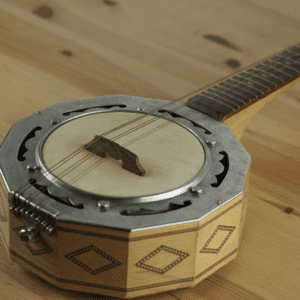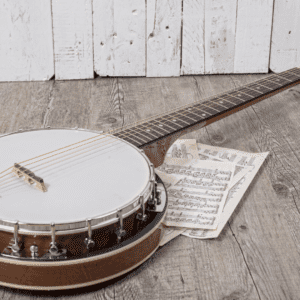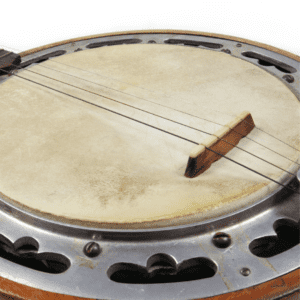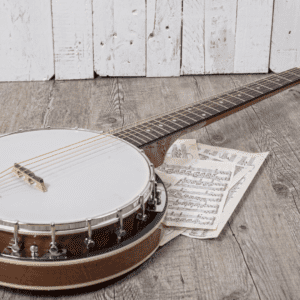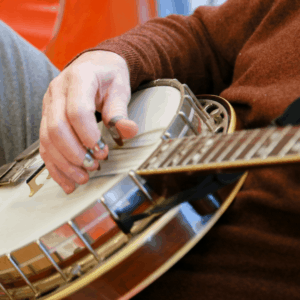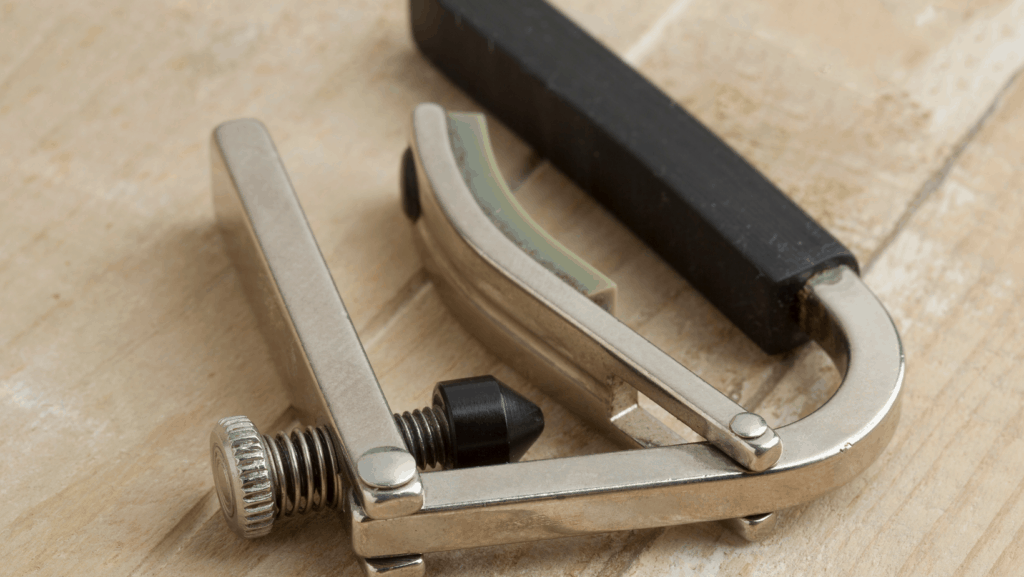
Most people who use a capo use it on a 6-string acoustic or electric guitar. But did you know there are also capos built for other instruments? There are capos for 6 string guitars, 12 strings guitars, classical, flamenco, dobros, mandolins, and even ukuleles. Regardless of the instrument you play, first, you have to make sure that the capo is the right fit. If not it’ll at best be rendered useless and at worst could even damage your instrument.
Let’s look at some of the best banjo capos available on the market currently.
| 1. Best Banjo Capo Overall – Shubb C-5 Banjo Capo An excellent quality capo made by a trusted brand for over 35 years. A simple, easy-to-use, and reliable option. | Buy on Amazon | |
| | 2. Best Controllable Tension Banjo Capo – Paige Original Capo P-BN A capo with micro precision tension control to minimize intonation problems. When not in use it can be stored at the nut of the instrument. | Buy on Amazon |
| | 3. Best Versatile Banjo Capo – Planet Waves NS Banjo/Mandolin Capo A durable and lightweight aircraft-grade aluminum capo with micro-precision tuners. It’s designed for the 4 or 5 strings banjo and mandolin. | Buy on Amazon |
| | 4. Best 5th String Banjo Capo – Shubb Banjo Capo, Silver (FS) The original 5th string banjo capo that can be used up to the 10th fret. | Buy on Amazon |
| | 5. Best Easy To Use Banjo Capo – Kyser Quick-Change Capo The original clip-and-change capo. It’s handy to use and can be clipped on the head of the banjo when not in use. | Buy on Amazon |
5 Best Banjo Capos Reviewed
Best Banjo Capo Overall – Shubb C-5 Banjo Capo
Shubb is a brand made by musicians for musicians, trusted for over 35 years. The C5 is the original banjo capo and has an appealing polished nickel finish. By the flick of a lever, the rubber sleeve applies the right amount of pressure on the strings, assuring perfect intonation every time.
Shubb capos provide the right amount of pressure on the strings. Shubbs innovative design prevents too much pressure which is well known to stretch the strings out of tune. The C5 contains an over-center locking mechanism that contains unparalleled power, speed, accuracy and is user-friendly.
Shubbs is also excellent at eliminating tuning problems. The rubber that comes into contact with the strings is designed to be soft and pliant like a fingertip, so the strings aren’t bent over the strings as can happen with other capos.
Pros
- Easy to use – as simple as locking and forgetting about it.
- Custom rubber acts like your fingertip keeping your banjo in tune.
- Built by a trusted brand for over 35 years.
- Excellent build quality.
Cons
- Some people complain of the capo popping off if it’s accidentally knocked whilst playing.
Best Controllable Tension Banjo Capo – Paige Original Capo P-BN
The original Paige 5 strings banjo capo is built to last. Designed and manufactured in Michigan, USA. Paige claims to be the only manufacturer who produces everything completely in the USA. The high quality of the build controls the tension of the strings and thus avoids any annoying fret buzz that can distract you from your groove.
Another great feature of the Paige original capo is how you can store it behind the nut of the banjo when you’re not playing. Hopefully, this can reduce your chances of losing it, although even this seems unlikely given how they seem to disappear. The look and feel of this capo are exceptional.
It has a standard profile and radius, meaning that you should be able to use it on many different instruments. You should also be able to use it on the lower frets or wider than average instruments too.
Pros
- Precision controls allow change over the strings, meaning the best tone with fewer intonation problems.
- Upgraded glips for easier use.
- Upgraded clear tubing for longer life.
- Can be stored behind the nut of the instrument when not in use.
Cons
- The shipped item is a different color to the picture so be warned!
Best Versatile Banjo Capo – Planet Waves NS Banjo/Mandolin Capo
The Planet Waves capo is designed for either the 4 or 5 string banjo or mandolin. It has a mechanism for making micro-adjustments to get the right amount of string tension that you need. This will give you a clearer tone as it can help cut down on fret buzz and notes ringing out when you don’t want them to. It can also reduce the need for frequent retuning that can happen when you use a capo.
The aircraft-grade aluminum construction is lightweight and durable, ensuring the likelihood of it standing up to the rigors of touring and travel.
Pros
- Designed for 4 of 5 string banjo or mandolin.
- Has a micro-adjustment mechanism for the perfect sound on every occasion.
- Built with aircraft-grade aluminum that’s incredibly durable and lightweight.
Cons
- Takes longer to take on and off than others, which may not make it a good fit for the stage.
Best 5th String Banjo Capo – Shubb Banjo Capo, Silver (FS) –
This is the original offering by Shubb that got the company going back in 1974. It’s retained its popularity throughout the decades and many claim it’s still the best fifth-string banjo capo out there. It provides enough pressure to fret the strings by the use of a lever system instead of a spring.
The construction is sturdy, reliable, and unobtrusive. Installation requires the drilling of a few holes into the neck of your banjo, all you have to do is move the slider to the fret you want and screw it down. The slider can reach up to the 10th fret, giving you plenty of key options to choose from.
The design minimizes tonal distortion, meaning you shouldn’t have to retune regularly which makes it a good choice for live performances.
Pros
- The original 5th string banjo capo.
- Can reach up to the 10th fret, giving you the option to play in many different keys.
- Minimizes tonal distortion.
Cons
- Some don’t like the bulky addition to the neck of their banjo.
Best Easy To Use Banjo Capo – Kyser Quick-Change Capo
The Kyser quick-change capo is designed for banjos, mandolins, and ukuleles. It’s the original one-hand quick-change capo that many people are familiar with these days. It has a small body with no radius making it perfect for smaller instruments.
It’s built to last and does exactly what you want it to; raise the pitch of your instrument and save you having to use different fingering or chord shapes. The Kyser quick change allows you to transpose the key you’re playing in in seconds and with one hand. Simplicity and ease of use are what is at the heart of this often imitated design of capo by Kyser.
Pros
- The original quick change, one hand capo.
- Can be clipped to the head of your instrument when not in use.
- Hand-made in Texas.
- Lifetime guarantee.
Cons
- Some people voice concern over the tightness of the capo when new.
Banjo Capo Buying Guide
What Exactly Is A Capo And Why Do You Need One For Your Banjo?
A capo is something you place on the fretboard of your banjo to raise the pitch. It reduces the length of the strings and also lowers the action, making your banjo somewhat easier to play. It also makes it easier to play with different musicians as you can change keys easily.
The word capo is short for capodastro, or capotasto which means the ‘head of the fretboard.’ The head of the fretboard is also known as the nut. A capo is something used by musicians on stringed instruments, typically fretted ones, to reduce the length of the strings. This raises the pitch of the instrument and transposes it, making it an especially useful device for accompanying vocalists or if you sing yourself.
What a capo does is mimic the nut at the top of your instrument, bringing it higher up the neck to a place of your choosing. It’s also worth noting that when you place a capo on your instrument, the notes behind the capo are muted and unplayable. Just like when not using a capo, all playing has to be done below the nut.
Using a capo frees up your fingers. For example, if you want to play a barre chord, then your first and possibly even second fingers will be tied up doing so, giving you little option for further expression and flourishes. Placing a capo on the fret you were barring frees up your fingers and thus gives you far more harmonic and melodic possibilities than playing barre chords could.
By moving the capo up the banjos fretboard, you are raising the pitch of the open strings, thus changing the key. This can be especially useful if you’re playing with other musicians as it can save you the hassle of learning completely new chord shapes and sequences. As such is a useful and inexpensive piece of kit to have kicking about in your gig bag.
What Are The Different Types Of Banjo Capo?
Sliding capos are popular on the banjo for frets 1-4. For the 5th string, players can either opt for a rail which is attached to the side of the banjo with a sliding clamp on it, railway spikes that are drilled into the fretboard under which the string is placed, or an independent movable clamp.
Which type you choose will depend on whatever works best for you.
What’s Special About The Banjo Capo?
The most common type of banjo is the 5 string, and the 5th string starts at the 5th fret of the banjo. This makes most sliding capos (built specifically for the banjo or other instruments) only viable until the fourth fret (the key of B.) This means you need something else to capo the 5th string.
As the 5th string of a banjo begins at the 5th fret, this makes many capos built for other instruments useless beyond the fourth fret. That’s to say, in standard tuning, you’ll be able to transpose from G (and open strum on the banjo) to G♯, A, B♭ , and B and no further.
Also if you try to tune the 5th string above the key of A (capo on the 2nd fret) you could risk breaking the string, so you need something else to capo the fifth string.
Most professional players use small model railroad spikes placed in frets 7 and 9 onto which you can hook the strings. A 7th fret spike will change the 5th string (G) up a whole tone to A, which would make it compatible with a capo on the second fret of the first four strings. Likewise, the fifth string capo’d on 9 will equal B. Playing in the C, you can place the 5th string under the 9th fret spike and tune up a half step.
Some players prefer to use a sliding fifth string capo for their banjo. This is a rail that you screw onto the side of the banjo with a sliding, adjustable clamp that you tighten with a thumbscrew on the desired fret.
Can You Use Capo’s Built For Other Instruments On Your Banjo?
A guitar capo will most likely be too wide. It might work if you can somehow make sure all the strings are pressed down with enough tension. A mandolin or ukulele capo may fit on your banjo as the dimensions and curvature of the fretboard are more likely to be similar.
Different fingerboards also have different curvatures, meaning that the capo will have to mimic this angle if it’s to depress all the strings. Classical guitars, for example, have straight fingerboards, meaning that they need a capo with no curvature to press down all strings with equal pressure.
Keeping this in mind, it’s always best to find a capo that’s designed for your instrument for optimal performance and results. So, a banjo capo will, as the name implies, work best for your banjo. That said, there’s no harm in trying your capo on different instruments with similar dimensions to see if it works.
What’s The Best Kind Of Capo For the 5th String Of A Banjo?
Many professionals tend to prefer railroad spikes, but on the whole sliding 5th string capos are more popular. It’s easier to use once installed and doesn’t distort the pitch as much as railroad spikes can.
Some players don’t like the raised feel of the rail, which you attach to the neck with three small screws. It can get in the way for players who like to fret the fifth string with their thumb. A sliding capo is also much faster to use, and can even allow you to change tuning whilst playing, which wouldn’t be possible with spikes.
If you’re worried about drilling holes into your instrument, spikes don’t actually cause any damage to the instrument. You can also fill in the holes later if you decide that the spikes aren’t for you.
To Conclude
The capo is a fabulous invention that allows you to transpose your playing by moving the nut of your instrument higher up the fretboard. What this does is shortens the playable length of the strings and raises the pitch. It allows you to change key without changing chord positions. This makes it a valuable piece of kit to have if you want to play with other musicians or vocalists.
Different instrumentalists tend to favor whatever key is easiest on their particular instrument. A capo is an easy way to meet in the middle somewhere to play together. It’s also useful when accompanying singers. Different voices each have a different range that their comfortable singing in, and a capo helps in making this easily achievable.
The Shubb C-5 Banjo Capo is our top pick due to its ease of use and the esteem that the company has in the eyes of the consumers. Shubbs has been revered for the quality of its products for over 35 years, and the quality and build of their products hasn’t declined in that time. This capo is also very good at keeping intonation problems at bay, which can be the Achilles heel of any capo.
Last update on 2023-04-27 / Affiliate links / Images from Amazon Product Advertising API


